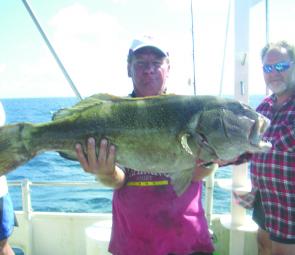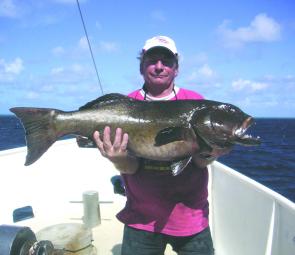Local knowledge is secondary when it comes to catching big reef fish. Instead, it’s more important to know the habits of the fish themselves if you plan to keep the fridge full of fine table fare.
At least that’s the opinion of Airlie fisherman, Brad Bowring. His proof lies in his own freezer – it’s chockablock and the neighbours are always hanging over the fence asking if he’s got any spare coral trout, emperor or nannygai.
The burly builder gets away to the reef every chance he gets and loves nothing more than hammering the local piscine population. And he’s a bloke who gets plenty of opportunities. If he’s not on his own boat with a few mates, he’s helping out another mate by ‘working’ as a deckie on his charter boat.
“Laurie and Karen Norris, from Proserpine, operate a 65ft Stella Maris out of Airlie and take visitors out to the reef for two days of fishing. I volunteer to help put their bait on the hooks and clean and fillet their fish as long as I get my turn on a rod,” Brad told Fish and Boat.
“A lot of them are up from Brisbane and bring along light gear – whiting rods and 30lb line. They might work OK down south but they’re not much good if you’re after the bigger fish out at the reef,” he said.
“If I hook a fish, my aim is to get it in the boat as quickly as possible. I don’t want to take any chances of it snapping the line or a shark taking it as it fights on light gear.
“I reckon if you’re fair dinkum about landing big fish, you’ve got to use heavy gear that won’t break – ever. I use 100kg braid and I’ve got a few Ugly Stiks and they never let me down.”
Brad reckons the best time to head out to the reef is during neap tides. “I like to go out about 4pm and come back in about 3 in the morning. You have to know the shoals around the reef and know where the shallows are, where the bumpers are and when the tide will be moving over them. The sounder on your boat will find the fish for you but you need to know how they target their prey.
“The big trout, emperor and nannygai often sit on the ocean side of these bumpers when the tide’s running out and pick off the smaller fish as they swim through the turbulence.”
He reckons the best fishing can be done off Gould and Black reefs and Edwards Island but adds you can’t go wrong anywhere on along the reef. “We’re always finding great new spots. You’ll be fishing deep water at around 50m and if you’re using light gear, you need to tie a brick to your line so it doesn’t get swept away,” Brad said.
“I prefer squid as bait and although frozen bait from the shops works OK, I’ve always preferred live bait you catch yourself. They seem to work a lot better.
“We’re always pulling plenty of big fat coral trout, red and spangled emperor, nannnygai and plenty of other reef species, including giant trevally. Nearly all of them are perfect for the table.
“But you never know what you’ll catch. I’ve found that the trout will come up into the warmer water in the cooler months and you can catch them in just five metres of water.
“And another time, I pulled a big Spanish mackerel up from 90m. I’ve got no idea what it was doing down there as they’re pelagic fish and supposed to be patrolling a lot closer to the surface,” he said.
“I just enjoy getting out on the water and catching a few fish. The haul on a recent trip was pretty typical when I pulled in a 35kg spanish mackerel, a 22kg coral trout and a 30kg GT, all pretty close together. That certainly convinced the other blokes on the boat the value of heavy gear,” Brad said.
"You're basically guaranteed to catch some great reef fish and keep the family and friends with plenty of tasty fillets for the barbecue.
"Personally, I find squid is an excellent bait out at the reef and it works even better if you catch them fresh where you are planning to get among the bigger fish.
"If you're bottom bashing, you'll catch no end of coral trout, spangled and red emperor and you can generally get a few pelagics like mackerel if you do a bit of trolling.
"If you're planning on targeting emperor, night fishing will always get you a few. I like to head out about 4 in the afternoon and head back in at 3 in the morning and nearly always come back with a fridge full of good eating fish.
"You catch them in the deeper water and that's why you need the heavy line. Once you've got them hooked, you want to get them up and into the boat as quick as you can as there's a few sharks out there that will take the fish if you're fighting with it too long on the lighter gear," Brad said.
"We regularly bring in emperor and trout well over the 10kg mark and quite often up into the 30kg range.
"The beauty of fishing out at the reef is that if you have a look for some spots, you'll always find them. We keep finding new beaches or shoals of fish on the sounder - you've just got to get out and have a look around.
"While the best eating fish are generally caught down deep, you'll quite often find some nice trout in shallow waters in the warmer months, sometimes only five metres down.
"But you never know what you're going to catch. I pulled up a mackerel from 90m one day and they're supposed to be surface predators. You can almost guarantee you'll get a surprise if you keep dropping a line," he said.
Brad's biggest catches have included 2kg trout, a 32kg giant trevally and a 35kg spanish mackerel "that really made me work hard".
"I was glad I had the heavy line on that day. That mackerel took off and dragged out most of my line, at least 200m. You can hit them hard with the braid and I managed to drag it in in about 20 minutes. If I'd been using say 50lb mono, it would have taken hours. If it's fighting hard, you have to get it into the boat quick smart or a shark will take it," he said.
This is one bloke who knows his region well and shows that local knowledge isn’t the only thing that catches fish. – Laurie Mills
Reads: 4648
Brad Bowring with a 22kg coral trout – proof that heavy gear works well.

Brad shows off a 30kg GT caught out near the reef off Airlie Beach recently.




